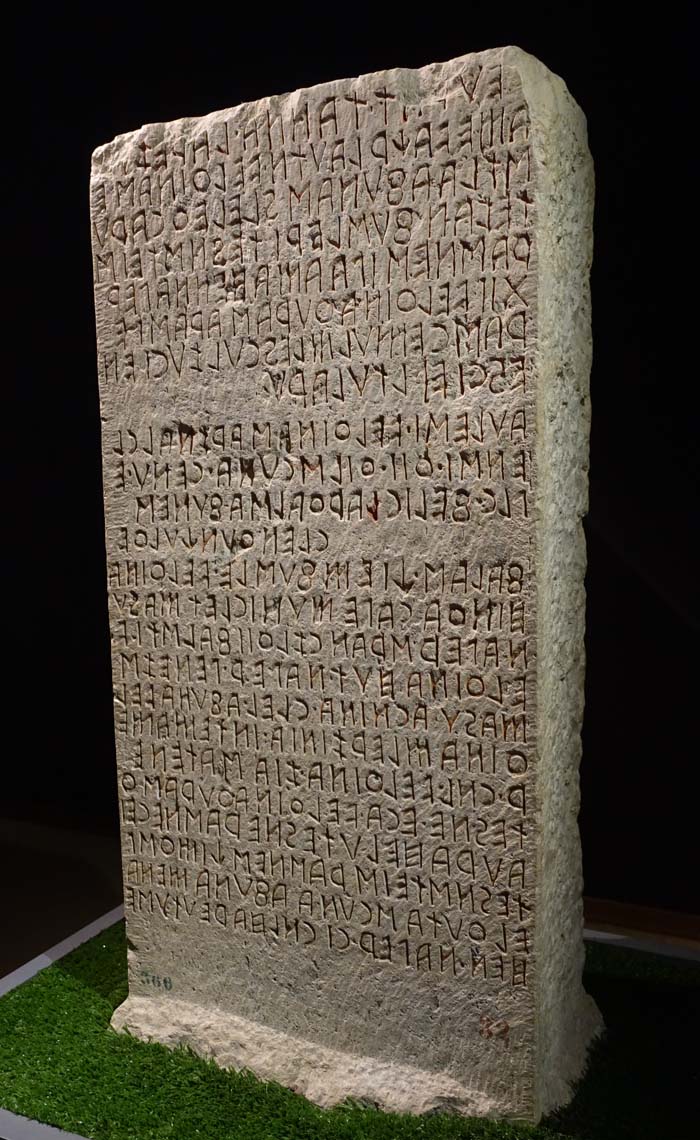Skip to comments.
'Round A Table of Wines and Wars: Agricultural Practices of the Etruscans
CBTNews Features ^
| 2006
| CropBiotech Net
Posted on 04/17/2019 11:17:10 PM PDT by SunkenCiv
The Italian peninsula seems to shimmer and shine with history and art, from graceful, full bodied nymphs set against make-believe cypresses and oaks, to crumbling mounds of marble on which lie the almost breathable, almost visible words of lives, songs, and politics past. But before all the art, before the reawakening, before the soldiers cloaked in scarlet and gold, and the senators in their Senate hall...before the reign of emperors and tyrants was a race of peoples whose culture lived on in the greatest empire the world has ever known.
They were the Etruscans, a mysterious tribe that scattered throughout northeastern and southern Italy, and brought civilization and urbanization in their wake... Their origins are still disputed; early accounts from the Greek historian Herodotus claimed that they were migrants from Asia Minor. Dionysius, another Greek historian, wrote that the Etruscans were native to Italy...
The Etruscans planted cereals such as barley, millet, panic grass (grass used for fodder) and rye, from which they extracted "puls," the precursor of today's bread. They cultivated olives, grapes, garlic, onions, ceci beans, black eyed peas, fava beans, and lupins. Fruit groves throughout the city states were heavy with pomegranates, figs, blackberries, strawberries, and egg-sized apples and melons. In the barns and yards roamed cows, pigs, chickens, ducks, geese, goats, and sheep. The forests were replete with game, which included hare, deer, and wild boar. From the sea came fresh fish, tuna, and tortoise eggs. In the house, rolling pins rolled out dough, and cutting wheels turned to make fresh pasta. Cellars and cabinets were filled with olive oil and wine.
The Etruscans, in other words, were the rock on which gourmet Italian cooking would be built.
(Excerpt) Read more at isaaa.org ...
TOPICS: History; Science; Travel
KEYWORDS: agriculture; ancientnavigation; animalhusbandry; asiaminor; dietandcuisine; epigraphyandlanguage; etruria; etruscan; etruscans; godsgravesglyphs; helixmakemineadouble; herodotus; huntergatherers; italy; middleages; mtdna; navigation; oenology; renaissance; romanempire; tuscany; zymurgy
Navigation: use the links below to view more comments.
first 1-20, 21-30 next last
"They kneaded their bread, practiced boxing, and whipped their slaves to the sound of pipes." -- Athenaeus of Naucratis
Our ticket to the art museum also got us into several other museums in Perugia, so after a cup of strong Italian coffee (sipped under an umbrella since it was still raining) we made our way down the hill to the archeology museum which is filled with ancient Roman ruins, prehistoric tools and artifacts, and a tablet with the oldest known example of Etruscan writing. | Etruscan boundary stone, Cippus Perusinus | The Intrepid Tourist | September in Umbria, Italy, Part 1: Perugia and Deruta | Author Caroline Arnold's travel blog | Monday, September 28, 2015

1
posted on
04/17/2019 11:17:10 PM PDT
by
SunkenCiv
2
posted on
04/17/2019 11:19:08 PM PDT
by
SunkenCiv
(Imagine an imaginary menagerie manager imagining managing an imaginary menagerie.)
Etruscan DNA Part 1 | Classics Confidential | interview with Dr Phil Perkins of The Open University

3
posted on
04/17/2019 11:19:40 PM PDT
by
SunkenCiv
(Imagine an imaginary menagerie manager imagining managing an imaginary menagerie.)
Etruscan DNA Part 2 | Classics Confidential | interview with Dr Phil Perkins of The Open University

4
posted on
04/17/2019 11:19:46 PM PDT
by
SunkenCiv
(Imagine an imaginary menagerie manager imagining managing an imaginary menagerie.)
To: StayAt HomeMother; Ernest_at_the_Beach; 1ofmanyfree; 21twelve; 24Karet; 2ndDivisionVet; 31R1O; ...
5
posted on
04/17/2019 11:20:00 PM PDT
by
SunkenCiv
(Imagine an imaginary menagerie manager imagining managing an imaginary menagerie.)
To: SunkenCiv
6
posted on
04/17/2019 11:31:15 PM PDT
by
pax_et_bonum
(Never Forget the SEALs of Extortion 17 - and God Bless The USA and President Trump.)
To: SunkenCiv
"...
whose culture lived on in the greatest empire the world has ever known."
The Pizza Empire.

8
posted on
04/17/2019 11:32:41 PM PDT
by
SunkenCiv
(Imagine an imaginary menagerie manager imagining managing an imaginary menagerie.)
To: Telepathic Intruder
9
posted on
04/17/2019 11:48:27 PM PDT
by
SunkenCiv
(Imagine an imaginary menagerie manager imagining managing an imaginary menagerie.)
To: pax_et_bonum
My pleasure, glad you like it. I'd had this on deck, incomplete, for a few months.
10
posted on
04/17/2019 11:49:35 PM PDT
by
SunkenCiv
(Imagine an imaginary menagerie manager imagining managing an imaginary menagerie.)
To: SunkenCiv
If you've seen The Lord of the Rings (Peter Jackson's), by the way, you might notice that there's something missing from the culture of the Gondorians. They have magnificent walled cities, but no AGGRICULTURE. No FOOD.

rest of the Etruscans keyword, chrono sort:
12
posted on
04/18/2019 12:06:28 AM PDT
by
SunkenCiv
(Imagine an imaginary menagerie manager imagining managing an imaginary menagerie.)
To: Telepathic Intruder
The farmers and herders were tucked away behind Minas Tirith I think -- after the loss of Osgiliath and and verdant area by the River, things probably got a little tight.
13
posted on
04/18/2019 12:08:32 AM PDT
by
SunkenCiv
(Imagine an imaginary menagerie manager imagining managing an imaginary menagerie.)
14
posted on
04/18/2019 12:13:25 AM PDT
by
SunkenCiv
(Imagine an imaginary menagerie manager imagining managing an imaginary menagerie.)
To: Telepathic Intruder
Pizza good.
Where's my full bodied nymph though ?
15
posted on
04/18/2019 1:26:11 AM PDT
by
onona
(It is often wise to allow a person a graceful path.)
To: Telepathic Intruder
Too bad the Etruscans had no tomatoes.
To: SoCal Pubbie
... or spices or hat cake later to Sicily.
Sicilian women can really cook.
To: SoCal Pubbie
Really? No tomatoes, no civilization as we know it.
To: Telepathic Intruder
Tomatoes are native to South America. Italian cooking was a lot different before Columbus.
To: SoCal Pubbie
Ah. A lot of stuff we take for granted today are native to the Americas. Potatoes, corn (maize, rather), sugar, lots of other things probably. Agriculture is what put Native Americans in the late stone age. It was actually pretty advanced.
Navigation: use the links below to view more comments.
first 1-20, 21-30 next last
Disclaimer:
Opinions posted on Free Republic are those of the individual
posters and do not necessarily represent the opinion of Free Republic or its
management. All materials posted herein are protected by copyright law and the
exemption for fair use of copyrighted works.
FreeRepublic.com is powered by software copyright 2000-2008 John Robinson





